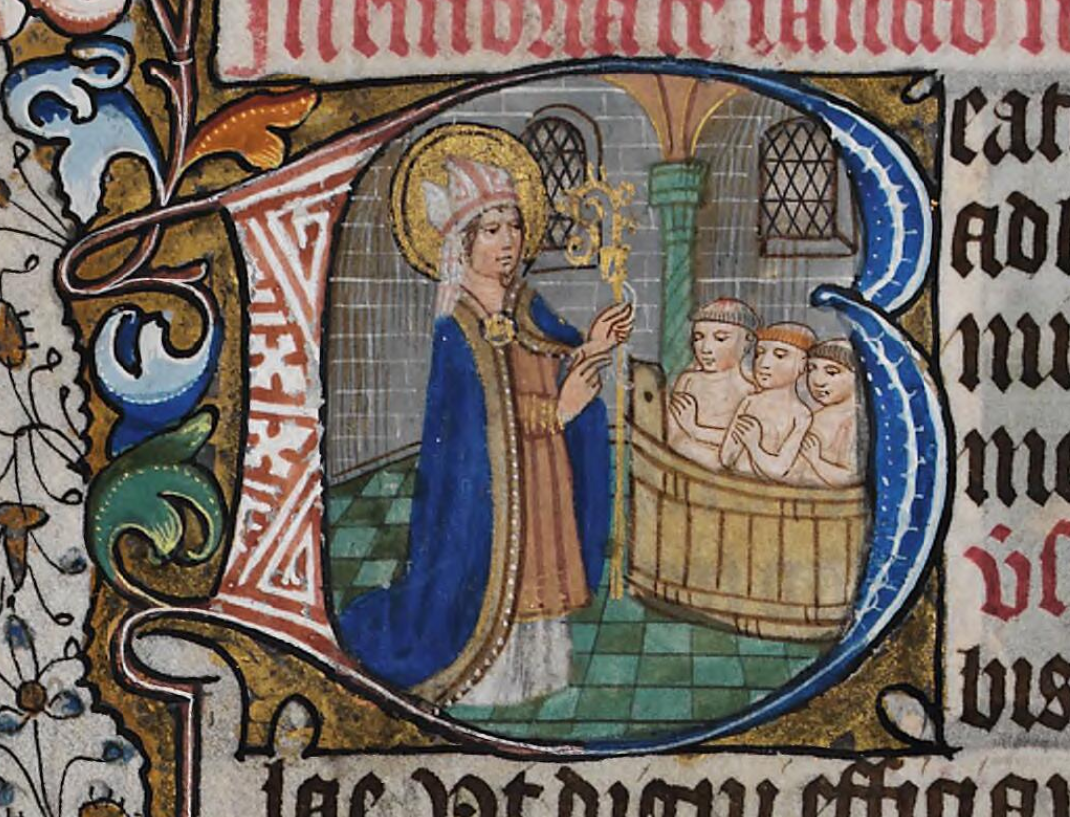The liturgy is becoming more intense in the lead up to Christmas. This Sunday at Matins the invitatory antiphon has become 'The Lord is now near O come, let us adore Him'.
And from next Saturday we enter the most intense part of the liturgy in the lead up to Christmas, with daily sets of antiphons for the psalms from Lauds to Vespers, and special sets of canticle antiphons.
At Lauds, the Benedictus antiphons are mostly those of the day of the Advent week, but there are some reserved for particular dates. At Vespers though, we sing the famous 'O Antiphons' which particular to the dates.
I'll post some notes on the liturgy each day once the O antiphons start, but as requested, herewith a short introduction.
An ancient tradition
Just how old the O antiphons are is not known, however they seem to have been known in sixth century Italy, given a reference to them by St Benedict's contemporary, St Boethius.
At Fleury, famous (or infamous depending on your perspective!) for its raid on Monte Cassino to acquire the relics of SS Benedict and Scholastica circa 660, the antiphons were recited by the abbot and senior monks in descending rank, and then a gift was given to each member of the community.
The texts of the O antiphons will probably seem pretty familiar to most people, because they were paraphrased into a twelfth century hymn, Veni, veni Emmanuel (O Come O come Emmanuel) which continues to be sung in both English and Latin in numerous versions.
The texts
Each of the texts refers to key prophesies of Christ, mostly from Isaiah. There is, however, another level to them, as they have been arranged so that if you work backwards, the first letter of each one together forms two words, viz Ero Cras, or tomorrow I will come, viz:
(December 23) O Emmanuel, Rex et legifer noster, exspectatio Gentium, et Salvator earum: veni ad salvandum nos, Domine, Deus noster. (O Emmanuel, our king and our lawgiver,
the hope of the nations and their Saviour: Come and save us, O Lord our God.)
(December 22) O Rex Gentium, et desideratus earum, lapisque angularis, qui facis utraque unum: veni, et salva hominem, quem de limo formasti. (O King of the nations, and their desire,
the cornerstone making both one: Come and save the human race, which you fashioned from clay.)
(December 21) O Oriens, splendor lucis aeternae, et sol justitiae: veni, et illumina sedentes in tenebris, et umbra mortis. (O Dayspring, splendour of light eternal and sun of righteousness:
Come and enlighten those who dwell in darkness and the shadow of death.)
(December 20) O Clavis David, et sceptrum domus Israel; qui aperis, et nemo claudit; claudis, et nemo aperit: veni, et educ vinctum de domo carceris, sedentem in tenebris, et umbra mortis. (O Key of David and sceptre of the House of Israel; you open and no one can shut; you shut and no one can open: Come and lead the prisoners from the prison house, those who dwell in darkness and the shadow of death.)
(December 19) O Radix Jesse, qui stas in signum populorum, super quem continebunt reges os suum, quem Gentes deprecabuntur: veni ad liberandum nos, jam noli tardare. (O Root of Jesse, standing as a sign among the peoples; before you kings will shut their mouths, to you the nations will make their prayer: Come and deliver us, and delay no longer.)
(December 18) O Adonai, et Dux domus Israel, qui Moysi in igne flammae rubi apparuisti, et ei in Sina legem dedisti: veni ad redimendum nos in brachio extento. (O Adonai, and leader of the House of Israel, who appeared to Moses in the fire of the burning bush and gave him the law on Sinai:
Come and redeem us with an outstretched arm.)
(December 17) O Sapientia, quae ex ore Altissimi prodiisti, attingens a fine usque ad finem, fortiter suaviterque disponens omnia: veni ad docendum nos viam prudentiae. (O Wisdom, coming forth from the mouth of the Most High, reaching from one end to the other, mightily and sweetly ordering all things: Come and teach us the way of prudence.)
Truly, I will come...
But there is also a very nice piece of the English tradition that is worth knowing about. In medieval England an eighth antiphon was added by starting the set a day early and adding an extra antiphon to the end of the sequence, thus making the acrostic Vero cras, or truly tomorrow (I will come). An alternative solution, adopted in the recording below, is to sing it on December 24.
Here is the traditional text:
O Virgo virginum, quomodo fiet istud?
Quia nec primam similem visa es nec habere sequentem.
Filiae Jerusalem, quid me admiramini?
Divinum est mysterium hoc quod cernitis.
Or:
O Virgin of virgins, how shall this be?
For neither before thee was any like thee, nor shall there be after.
Daughters of Jerusalem, why marvel ye at me?
The thing which ye behold is a divine mystery.
The O antiphons are pretty easy to learn, as they all have a very similar chant tone. Over time of course, numerous other settings of them have also been made.






